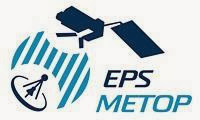
ESA - EPS METOP Mission logo / ESA - Sentinel-3 Mission patch.
13 January 2014
Like thermometers in the sky, satellite instruments can measure the temperatures of Earth’s surfaces. ESA’s new GlobTemperature project is merging these data from a variety of spaceborne sensors to provide scientists with a one-stop shop for land, lake and ice temperature data.
Information on land surface temperature is a key parameter for studying the Earth system. It plays an important role in physical processes such as atmospheric convection and surface evaporation, biological processes like vegetation sensitivity to stress and to fire, and chemical processes such as emissions of gases from the surface to the atmosphere.
Long-term trends in surface temperature can also be an indicator of climate change.
Land surface temperature
Meteorologists and climate scientists rely heavily on air temperature measurements made using thermometers installed at ground-based weather stations despite the availability of satellite-derived measurements. This is mainly due to the complexity of the data from different satellite instruments, utilising both infrared and microwave data, and the variety of formats in which the data are made available.
It is also difficult to convert the satellite measurements of the temperature of the solid land surface to the commonly used air temperature. An example of this is the difference in temperature between hot tarmac and cooler grass on a summer’s day even at the same air temperature.
In addition, satellite data suffer from gaps due to cloud cover or provide limited sampling of the day/night temperature cycle.
Temperature changes
To fill these gaps and better meet users’ needs for land surface temperature data, ESA recently initiated the GlobTemperature project under the Data User Element Programme.
GlobTemperature will merge surface temperature data from a variety of satellites into a common format which will be made available in a single online archive.
The data will come from instruments including SEVIRI on Europe’s MSG mission, AVHRR and IASI on MetOp, as well as American and Japanese instruments and from the upcoming Sentinel-3 mission. Archived data from the (A)ATSR instruments flown on the ERS and Envisat missions will also be included.
The new, global datasets developed under GlobTemperature will provide a more complete representation of day and night temperatures, including estimates of clear-sky versus cloudy sky biases.
Related links:
GlobTemperature: user consultation meeting: http://due.esrin.esa.int/meetings/meetings278.php
Data User Element: http://dup.esrin.esa.it/
Estellus: http://www.estellus.fr/
UK Met Office: http://www.metoffice.gov.uk/
Danish Meteorological Institute: http://www.dmi.dk/dmi/index
Project consortium:
University of Leicester: http://www.le.ac.uk/
University of Reading: http://www.reading.ac.uk/
Instituto Portugues do Mar e da Atmosfera: https://www.ipma.pt/pt/
Karlsruhe Institute of Technology: http://www.kit.edu/english/
ACRI-ST: http://www.acri-st.fr/English/
ESA's Earth Observing missions:
Envisat overview: http://www.esa.int/Our_Activities/Observing_the_Earth/Envisat_overview
MetOp overview: http://www.esa.int/Our_Activities/Observing_the_Earth/MetOp_overview
Images, Text, Credits: ESA / University of Leicester.
Cheers, Orbiter.ch



